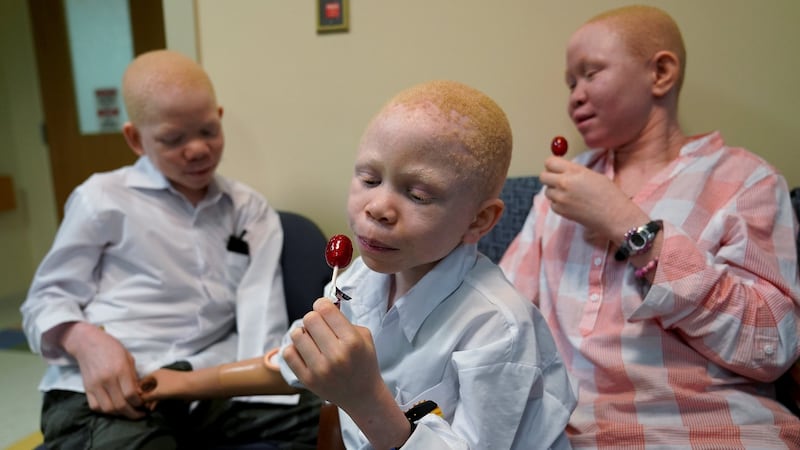Emmanuel Rutema couldn't keep the smile off his face as he tested out his new prosthetic arm and promptly knocked himself on the nose.
“Be careful with your face!” the hospital prosthetist told the boy.
Rutema is one of four Tanzanian children with albinism visiting the United States to get prosthetic limbs to replace those hacked off in brutal superstition-driven attacks in their east African homeland.
At Shriners Hospital for Children in Philadelphia on Tuesday three of them got the new limbs that will help them do everyday tasks that most people take for granted.
Rutema, the oldest at 15, speaks with difficulty. His attackers chopped off one arm and the fingers of the other hand and tried to pull out his tongue and teeth.
Also getting prosthetics were Baraka Lusambo (7) and Mwigulu Magesa (14) each of whom lost parts of their arms in attacks.
People with albinism live in danger in Tanzania where their body parts are used in witchcraft and can fetch a high price. Superstition leads many to believe they are ghosts and bring bad luck.
Albinism is a congenital disorder affecting about one in 20,000 people worldwide who lack pigment in their skin, hair and eyes, but it is more common in sub-Saharan Africa and affects about one Tanzanian in 1,400.
The Tanzanian children are getting treatment in the United States with support from the Global Medical Relief Fund (GMRF), a New York-based charity that hosts children from around the world who have been injured in conflict or disaster.
Elissa Montanti, founder of GMRF, called the children from Tanzania "gentle souls".
“When they come here, they have lost so much. They have lost part of their youth and part of their dignity,” Montanti said at the Philadelphia hospital.
“We put them back together. When they go back, they have a stronger sense of empowerment. I see such a difference.”
Second trip
For these children, this is the second trip to the United States for prosthetics and they leave next week. They first came two years ago and they have returned for larger limbs because they have grown. They could return again for larger equipment.
Their new arms are attached with shoulder harnesses, and the elbows and fingers are controlled with cables.
Within minutes, Lusambo, the youngest, was clowning around, using his new hand to erect a tower of plastic building blocks and chomping on a candy lollipop.
Magesa was more serious and stood stiffly as the prosthetist tugged at his harness straps and tightened its buckles.
Asked what he would be doing at home in Tanzania with his new arm, he said: “Washing clothes.”

The children attend boarding school and live in so-called safe houses in Tanzania. They rarely go out in public because it frightens them and could put them in danger, said Ester Rwela, a social worker with the charity Under the Same Sun who came with them to the United States.
United Nations officials estimate at least 75 albinos were killed in the east African nation between 2000 and 2015 but fear the number of reported attacks represent just a fraction of the total as most are secretive rituals in rural areas.
Under the Same Sun runs a public awareness campaign to dispel notions that the bodies of people with albinism have special powers or should be sacrificed for their limbs.
Superstition holds that having a piece of a person with albinism can bring luck finding a well-stocked fishing site or a plentiful gold mine or bring a victory in politics, Rwela said.
“What we are fighting with is the mindset of the people,” she said.
“When a witch doctor says, ‘Bring me a part of an albino and you will be successful,’ they go and do it. Someone can be educated, but they believe in superstition to be successful.”
About albinism
* Albinism is caused by a mutation in genes that affects the production of melanin. It is typically characterised by pale skin, light hair and poor vision, according to the US-based Mayo Clinic.
* Globally, one person in 18,000 has albinism, according to Standing Voice, a London-based albinism advocacy organisation. It is far more common in sub-Saharan Africa, and one person in 1,400 is affected in parts of Tanzania, the group says.
* In sub-Saharan Africa, people with albinism face discrimination, abandonment and poverty, according to Under the Same Sun, a Canadian-based group. Many husbands desert wives who give birth to a child with albinism, and superstition may lead them to abandon or kill their newborns. Children who survive may go to school, but vision problems lead to high dropout rates. Adults are shunned and not hired for jobs.
* People with albinism fall victim to ritual attacks in regions where superstition says their body parts bring power, wealth and good luck. Most victims are children, and body parts are often taken from live victims under the belief that the intensity of their screams increases their potency, according to the United Nations.
* More than 600 cases of attacks on people with albinism have been reported in 26 countries, mostly in the last eight years, said a UN report released this year. The actual number is likely higher, but reporting is hampered in part by family involvement in the attacks, it said.
*Violence against people with albinism is particularly severe in Tanzania, where there have been 76 murders and 73 documented attacks since 2006, according to Standing Voice.
Thomson Reuters Foundation











